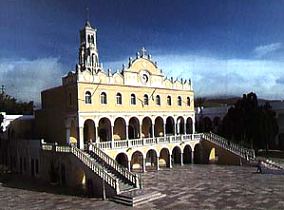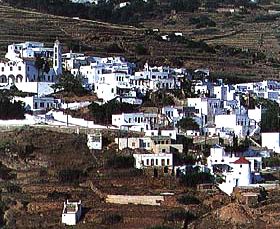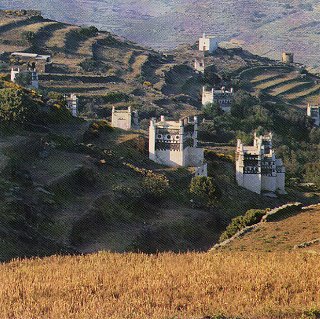|
|
Tinos Island
 Tinos is
untouristy, unspoilt, unaffected and just about every other
"un" except interesting and attractive. The hustle
and bustle of the main town and port contrast sharply with
rural atmosphere that pervades the rest of the hilly island.
Fat livestock, working windmills and dovecotes are as integral
a part of the landscape as the holiday accommodation and
tourist shops. Tinos is
untouristy, unspoilt, unaffected and just about every other
"un" except interesting and attractive. The hustle
and bustle of the main town and port contrast sharply with
rural atmosphere that pervades the rest of the hilly island.
Fat livestock, working windmills and dovecotes are as integral
a part of the landscape as the holiday accommodation and
tourist shops.
Situated in
the north Cyclades, Tinos has the reputation of attracting
boatloads of fanatical, religious pilgrims. With the exception
of the two holy days on March 25th and August 15,
this is an exaggeration to say the least. The miracle-working
icon and the Church of Evangelistria in Tinos Town are
certainly worth visiting as both have great beauty in addition
to their religious significant, but there are many other
reasons to visit Tinos. In particular, Tinos possesses some of
the most attractive villages in the Cyclades.
 The main
town if Tinos is a vibrant, quintessential Greek harbour town
with plenty of colour, shops, tavernas, cafes and a
never-ending stream of arriving and departing water craft.
Porto, by contrast, on the south coast of Tinos offers a
large, sandy bay conductive to a relaxing, beach-based holiday
in scenic surroundings.
History:
Tinos is the third largest island of the Cyclades. it's near
Syros, Mykonos and Andros. It boasts about 40 picturesque
villages. The island's name derives from the word tenok that
has a Phoenician origin and is the word for "snake",
because of the great number of snakes that used to slither
throughout the island. According to the ancient Greek
mythology the god Aeolus, master of the winds, lived in Tinos.
 The island flourishes throughout the duration of the Cycladic
civilization. During the Hellenistic years it becomes a member
of the Athenian alliance. In 800 BC it 'rs pillaged by
Mithridates. Later, until 1715 the island is occupied by the
Venetians. During the Turkish Domination it retains some of
the privileges of being self governing. Being the homeland of
great artists such as Giannoulis Halepas, Gyzis, Nikiphoros
Lytras and Philippotis it has a long tradition in
marble-sculpture, which continues as there is ac Arts school
with a sculpture laboratory. ln 1822 the picture of Virgin
Mary, that is considered miraculous is found in the island.
Thus in 1823 to the grace of Virgin Mary, the homonymous
temple was built and is until a center of worship for the
pilgrims. In 1940 a Italian submarine sunk the Greek destroyer
ELLI in the port of Tinos. The island flourishes throughout the duration of the Cycladic
civilization. During the Hellenistic years it becomes a member
of the Athenian alliance. In 800 BC it 'rs pillaged by
Mithridates. Later, until 1715 the island is occupied by the
Venetians. During the Turkish Domination it retains some of
the privileges of being self governing. Being the homeland of
great artists such as Giannoulis Halepas, Gyzis, Nikiphoros
Lytras and Philippotis it has a long tradition in
marble-sculpture, which continues as there is ac Arts school
with a sculpture laboratory. ln 1822 the picture of Virgin
Mary, that is considered miraculous is found in the island.
Thus in 1823 to the grace of Virgin Mary, the homonymous
temple was built and is until a center of worship for the
pilgrims. In 1940 a Italian submarine sunk the Greek destroyer
ELLI in the port of Tinos.
|
>> Cyclades Islands : Amorgos, Anafi,
Andros, Antiparos,
Delos, Folegandros,
Ios, Kea,
Kimolos, Kithnos,
Koufonisia, Milos,
Mykonos, Naxos,
Paros, Santorini,
Serifos, Sifnos,
Sikinos, Syros,
Tinos.
|
|